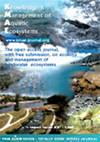对比过去30年法国双产卵鱼类种类和集水区数量的趋势
IF 1.7
3区 环境科学与生态学
Q3 FISHERIES
引用次数: 7
摘要
据报道,在很大范围的分类群中,种群数量的下降和崩溃。二恶英鱼在淡水和海洋之间迁徙,在其复杂的生命周期中遇到许多人为的压力。尽管具有生态、文化和经济利益,但几十年来,在世界许多地区,二产卵鱼的数量一直在减少。在这项研究中,我们利用位于18个集水区29条河流的43个监测站,调查了法国30年来5种双雄性鱼类数量的变化。我们的假设是,这些物种的数量在不同的集水区以不同的方式进化。我们还测试了可能对观察到的趋势有贡献的五个驱动因素的影响:集水区、纬度、商业渔业的存在、生态连续性的改善和鲑鱼放养。在全国范围内,不同种类的鱼类数量呈现出增加的趋势,如安圭拉(Anguilla Anguilla)和特鲁塔(Salmo trutta),略有增加(Salmo salar),减少的趋势(Alosa spp.和Petromyzon marinus)。对于每个分类单元,除安圭拉外,我们强调了显著的集水区效应,这表明了集水区和站点之间的差异趋势。然而,我们没有发现流域特征对任何研究分类群的显著影响。本文章由计算机程序翻译,如有差异,请以英文原文为准。
Contrasting trends between species and catchments in diadromous fish counts over the last 30 years in France
The decline and collapse of populations have been reported for a large range of taxa. Diadromous fishes migrate between fresh water and the sea and encounter many anthropogenic pressures during their complex life cycle. In spite of being of ecological, cultural and economic interest, diadromous fishes have been in decline for decades in many parts across the world. In this study, we investigated the change in five diadromous fish counts in France over a 30-year period using 43 monitoring stations located in 29 rivers across 18 catchments. Our hypothesis was that the counts of these species evolved in a contrasting way between catchments. We also tested the effect of five drivers potentially contributing to the observed trends: catchment, latitude, presence of commercial fisheries, improvement of ecological continuity and salmon stocking. We found contrasting trends in fish counts between species at the national scale, with some taxa increasing (Anguilla anguilla and Salmo trutta), some showing a slight increase (Salmo salar) and some decreasing (Alosa spp. and Petromyzon marinus). For each taxon, except Anguilla anguilla, we highlighted a significant catchment effect indicating contrasting trends between catchments and stations. However, we found no significant effect of catchment characteristics for any of the studied taxa.
求助全文
通过发布文献求助,成功后即可免费获取论文全文。
去求助
来源期刊

Knowledge and Management of Aquatic Ecosystems
环境科学-海洋与淡水生物学
CiteScore
3.70
自引率
5.60%
发文量
22
审稿时长
>12 weeks
期刊介绍:
Knowledge and Management of Aquatic Ecosystems (KMAE-Bulletin Français de la Pêche et de la Pisciculture since 1928) serves as a foundation for scientific advice across the broad spectrum of management and conservation issues related to freshwater ecosystems.
The journal publishes articles, short communications, reviews, comments and replies that contribute to a scientific understanding of freshwater ecosystems and the impact of human activities upon these systems. Its scope includes economic, social, and public administration studies, in so far as they are directly concerned with the management of freshwater ecosystems (e.g. European Water Framework Directive, USA Clean Water Act, Canadian Water Quality Guidelines, …) and prove of general interest to freshwater specialists. Papers on insular freshwater ecosystems and on transitional waters are welcome. KMAE is not a preferred journal for taxonomical, physiological, biological, toxicological studies, unless a clear link to ecological aspects can be established. Articles with a very descriptive content can be accepted if they are part of a broader ecological context.
 求助内容:
求助内容: 应助结果提醒方式:
应助结果提醒方式:


